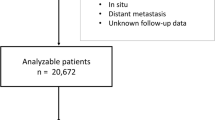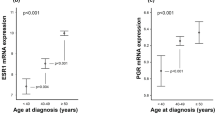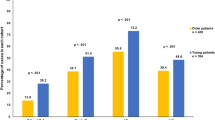Abstract
The predictive role of tumour proliferative rate and expression of p53, bcl-2 and bax proteins, alone and in association with tumour size, nodal involvement and oestrogen receptors (ER), was analysed on 145 elderly patients (≥70 years of age) with histologically assessed node-positive breast cancers treated with radical or conservative surgery plus radiotherapy followed by adjuvant tamoxifen for at least 1 year. The 7-year probability of relapse was significantly higher for patients with tumours rapidly proliferating (hazard ratio (HR) = 2.0, P = 0.01), overexpressing p53 (HR = 4.4, P = 0.0001), weakly or not exhibiting bcl-2 (HR = 1.9, P = 0.02), without ERs (HR = 3.4, P = 0.0001) or with ≥ 4 positive lymph nodes (HR = 2.3, P = 0.003) than for patients with tumours expressing the opposite patho-biological profile. Conversely, tumour size and bax expression failed to influence relapse-free survival. Adjustment for the duration of tamoxifen treatment did not change these findings. Oestrogen receptors, cell proliferation, p53 accumulation and bcl-2 expression were also predictive for overall survival. Within ER-positive tumours, cell proliferation, p53 accumulation, bcl-2 expression and lymph node involvement provided significant and independent information for relapse and, in association, identified subgroups of patients with relapse probabilities of 20% (low-risk group, exhibiting only one unfavourable factor) to 90% (high-risk group, exhibiting three unfavourable factors). Such data could represent the initial framework for a biologically tailored therapy even for elderly patients and highlight the importance of a patho-biological characterization of their breast cancers. © 2000 Cancer Research Campaign
Similar content being viewed by others
Article PDF
Change history
16 November 2011
This paper was modified 12 months after initial publication to switch to Creative Commons licence terms, as noted at publication
References
Archer SG, Eliopoulos A, Spandidos D, Barnes D, Ellis IO, Blamey RW, Nicholson RI and Robertson JFR (1995) Expression of ras p21, p53 and c-erbB-2 in advanced breast cancer and response to first line hormonal therapy. Br J Cancer 72: 1259–1266
Balducci L, Extermann M, Fentiman I, Monfardini S and Perrone F (1997) Should adjuvant chemotherapy be used to treat breast cancer in elderly patients (≥70 years of age)?. Eur J Cancer 33: 1720–1724
Balducci L, Silliman RA and Baekey P (1998) Breast cancer: an oncological perspective – part 1. In: Comprehensive Geriatric Oncology, Balducci L, Lyman GH, Ershler WB (eds), pp. 629–660. Harwood Academic Publishers: Amsterdam
Berns EMJJ, Klijn JGM, van Putten WLJ, de Witte HH, Look MP, Meijer-van Gelder ME, Willman K, Portengen H, Benraad TJ and Foekens JA (1998) p53 protein accumulation predicts poor response to tamoxifen therapy of patients with recurrent breast cancer. J Clin Oncol 16: 121–127
Carlomagno C, Perrone F, Gallo C, De Laurentiis M, Lauria R, Morabito A, Pettinato G, Panico L, D’Antonio A, Bianco AR and De Placido S (1996) c-erbB2 overexpression decreases the benefit of adjuvant tamoxifen in early-stage breast cancer without axillary lymph node metastases. J Clin Oncol 14: 2702–2708
Clahsen PC, van de Velde CJH, Duval C, Pallud C, Mandard A-M, Delobelle-Deroide A, van den Broek L, Sahmoud TM and van de Vijver MJ (1998) p53 protein accumulation and response to adjuvant chemotherapy in premenopausal women with node-negative early breast cancer. J Clin Oncol 16: 470–479
Costa A, Licitra L, Veneroni S, Daidone MG, Grandi C, Cavina R, Molinari R and Silvestrini R (1998) Biological markers as indicators of pathological response to primary chemotherapy in oral cavity cancers. Int J Cancer (Pred Oncol) 79: 613–623
Daidone MG, Luisi A, Di Fronzo G and Silvestrini R (1997) Biological characteristics of primary breast cancer in elderly. In: Comprehensive Geriatric Oncology, Balducci L, Lyman GH, Cuervo Henderson C, Ershler WB (eds), pp.197–200. Harwood Academic: Amsterdam
Di Fronzo G, Coradini D, Cappelletti V, Miodini P, Granata G, Schwartz M and Panko WB (1990) Hormone receptors and disease-free survival in breast cancer: impact of increasing threshold levels. Anticancer Res 10: 1699–1706
Early Breast Cancer Trialists’ Collaborative Group (1998) Tamoxifen for early breast cancer: an overview of the randomised trials. Lancet 351: 1451–1467
Elledge RM, Gray R, Mansour E, Yu Y, Clark GM, Ravdin P, Osborne CK, Gilchrist K, Davidson NE, Robert N, Tormey DC and Allred DC (1995 a) Accumulation of p53 protein as a possible predictor of response to adjuvant combination chemotherapy with cyclophosphamide, methotrexate, fluorouracil, and prednisone for breast cancer. J Natl Cancer Inst 87: 1254–1256
Elledge RM, Lock-Lim S, Allred D, Hilsenbeck SG and Cordner L (1995 b) p53 mutation and tamoxifen resistance in breast cancer. Clin Cancer Res 1: 1203–1208
Elledge RM, Green S, Howes L, Clark GM, Berardo M, Allred DC, Pugh R, Ciocca D, Ravdin P, O’Sullivan J, Rivkin S, Martino S and Osborne CK (1997) bcl-2, p53, and response to tamoxifen in estrogen receptor-positive metastatic breast cancer: a Southwest Oncology Group Study. J Clin Oncol 15: 1916–1922
Frassoldati A, Adami F, Banzi C, Criscuolo M, Piccinini L and Silingardi V (1997) Changes of biological features in breast cancer cells determined by primary chemotherapy. Breast Cancer Res Treat 44: 185–192
Gasparini G, Pozza F and Harris AL (1993) Evaluating the potential usefulness of new prognostic and predictive indicators in node-negative breast cancer patients. J Natl Cancer Inst 85: 1206–1219
Gasparini G, Barbareschi M, Doglioni C, Dalla Palma P, Mauri FA, Boracchi P, Bevilacqua P, Caffo O, Morelli L, Verderio P, Pezzella F and Harris AL (1995) Expression of bcl-2 protein predicts efficacy of adjuvant treatments in operable node-positive breast cancer. Clin Cancer Res 1: 189–198
Gee JM, Robertson JFR, Ellis IO, Willsher P, McClelland RA, Hoyle HB, Kyme SR, Finlay P, Blamey RW and Nicholson RI (1994) Immunocytochemical localization of bcl-2 protein in human breast cancers and its relationship to a series of prognostic markers and response to endocrine therapy. Int J Cancer 59: 619–628
Hellemans P, Van Dam PA, Weyler J, Van Oosterom AT, Buytaert P and Van Marck E (1995) Prognostic value of bcl-2 expression in invasive breast cancer. Br J Cancer 72: 354–360
Hurlimann J, Larrinaga B and Vala DLM (1995) bcl-2 protein in invasive ductal breast carcinomas. Vichows Archiv 426: 163–168
Hyman B and Muss MD (1994) The role of chemotherapy and adjuvant therapy in the management of breast cancer in older women. Cancer 74: 165–171
Jansson T, Inganas M, Sjogren S, Norberg T, Lindgren A, Holmberg L and Bergh J (1995) p53 status predicts survival in breast cancer patients treated with or without postoperative radiotherapy: a novel hypothesis based on clinical findings. J Clin Oncol 13: 2745–2751
Keen JC, Dixon JM, Miller EP, Cameron DA, Chetty U, Hanby A, Bellamy C and Miller WR (1997) The expression of Ki-S1 and bcl-2 and the response to primary tamoxifen therapy in elderly patients with breast cancer. Breast Cancer Res Treat 44: 123–133
Kobayashi S, Iwase H, Ito Y, Yamashita H, Iwata H, Yamashita T, Ito K, Toyama T, Nakamura T and Masaoka A (1997) Clinical significance of bcl-2 gene expression in human breast cancer tissues. Br Cancer Res Treat 42: 173–181
Krajewski S, Blomqvist C, Franssila K, Krajewska M, Wasenius VM, Niskanen E, Nordling S and Reed JC (1995) Reduced expression of proapoptotic gene bax is associated with poor response rate to combination chemotherapy and shorter survival in women with metastatic breast adenocarcinoma. Cancer Res 55: 4471–4478
Krajewski S, Thor AD, Edgerton SM, Moore II DH, Krajewska M and Reed JC (1997) Analysis of bax and bcl-2 expression in p53-immunopositive breast cancers. Clin Cancer Res 3: 199–208
Martelli G, De Palo G, Rossi N, Coradini D, Boracchi P, Galante E and Vetrella G (1995) Long-term follow-up of elderly patients with operable breast cancer treated with surgery without axillary dissection plus adjuvant tamoxifen. Br J Cancer 72: 1252–1255
McGuire WL, Tandon AK, Allred DG, Chamness GC, Ravdin PN and Clark GM (1992) Prognosis and treatment decisions in patients with breast cancer without axillary node involvement. Cancer 70: 1775–1781
Nathan B, Gusterson B, Jadayel D, O’Hare M, Anbazhagan R, Jayatilake H, Ebbs S, Micklem K, Price K, Gelber R, Reed R, Senn HJ, Gold HIRSCHA and Dyer MJS (1994) Expression of bcl-2 in primary breast cancer and its correlation with tumour phenotype. Ann Oncol 5: 409–414
Nicholson RI, Bouzubar N, Walker KJ, McClelland R, Dixon AR, Robertson JF, Ellis IO and Blamey RW (1991) Hormone sensitivity in breast cancer: influence of heterogeneity of oestrogen receptor expression and cell proliferation. Eur J Cancer 27: 908–913
Paik S, Bryant J, Park C, Fisher B, Tan-Chiu E, Hyams D, Fisher ER, Lippman ME, Wickerham DL and Wolmark N (1998) ErbB-2 and response to doxorubicin in patients with axillary lymph node-positive, hormone receptor-negative breast cancer. J Natl Cancer Inst 90: 1361–1370
Paradiso A, Tommasi S, Mangia A, Simone G and De Lena M (1990) Tumor proliferative activity, progesterone receptor status, estrogen receptor level, and clinical outcome of estrogen receptor-positive advanced breast cancer. Cancer Res 50: 2958–2962
Piffanelli A, Pelizzola D, Giovannini G, Catozzi L, Fagsgioli L and Giganti M (1989) Characterization of laboratory working standards for quality control of immunometric and radiometric estrogen receptor assays. Clinical evaluation on breast cancer biopsies. Tumori 75: 550–556
Ronchi E, Granata G, Brivio M, Coradini D, Miodini P and Di Fronzo G (1986) A double-labeling assay for simulataneous estimation and characterization of estrogen and progesterone receptors using radioiodinated estradiol and tritiated org 2058. Tumori 72: 251–257
Silliman RA, Balducci L, Goodwin JS, Holmes FF and Leventhal EA (1993) Breast cancer care in old age: what we know, don’t know, and do. J Natl Cancer Inst 85: 190–199
Silvestrini R (on behalf of the SICCAB Group for Quality Control of Cell Kinetic Determination) (1991) Feasibility and reproducibility of3H-thymidine labeling index in breast cancer. Cell Prolif 24: 437–445
Silvestrini R, Benini E, Daidone MG, Veneroni S, Boracchi P, Cappelletti V, Di Fronzo G and Veronesi U (1993 a) p53 as an independent prognostic marker in lymph node-negative breast cancer patients. J Natl Cancer Inst 85: 965–970
Silvestrini R, Daidone MG, Mastore M, Di Fronzo G, Coradini D, Boracchi P, Squicciarini P, Salvadori B and Veronesi U (1993 b) Cell kinetics as a predictive factor in node-positive breast cancer treated with adjuvant hormone therapy. J Clin Oncol 11: 1150–1155
Silvestrini R, Veneroni S, Daidone MG, Benini E, Boracchi P, Mezzetti M, Di Fronzo G, Rilke F and Veronesi U (1994) The bcl-2 protein: a prognostic indicator strongly related to p53 protein in lymph node-negative breast cancer patients. J Natl Cancer Inst 86: 499–504
Silvestrini R, Benini E, Luisi A, Veneroni S, Valentinis B and Daidone MG 1995a) Biology of breast cancer in elderly women. In: Mastology – Breast Disease. ASS: Figueira Fo (ed), pp. 255–258
Silvestrini R, Daidone MG, Luisi A, Boracchi P, Mezzetti M, Di Fronzo G, Andreola S, Salvadori B and Veronesi U (1995 b) Biological and clinicopathological factors as indicators of specific relapse types in node-negative breast cancer. J Clin Oncol 13: 697–704
Silvestrini R, Rao S, Benini E, Daidone MG and Pilotti S (1995 c) Immunohistochemical detection of p53 in clinical breast cancers: a look at methodologic approaches (Letter). J Natl Cancer Inst 87: 1020
Silvestrini R, Benini E, Veneroni S, Daidone MG, Tomasic G, Squicciarini P and Salvadori B (1996) p53 and bcl-2 expression correlates with clinical outcome in a series of node-positive breast cancer patients. J Clin Oncol 14: 1604–1610
Silvestrini R, Veneroni S, Benini E, Daidone MG, Luisi A, Leutner M, Maucione A, Kenda R, Zucali R and Veronesi U (1997) Expression of p53, GST-π and bcl-2 and benefit from adjuvant radiotherapy in breast cancer. J Natl Cancer Inst 89: 639–645
Sjøgren S, Inganas M, Lindgren A, Holmberg L and Bergh J (1998) Prognostic and predictive value of c-erbB-2 overexpression in primary breast cancer, alone and in combination with other prognostic markers. J Clin Oncol 16: 462–469
Stal O, Skoog L, Rutqvist LE, Carstensen JM, Wingren S, Sullivan S, Andersson AC, Dufmats M and Nordenskjold B (1994) S-phase fraction and survival benefit from adjuvant chemotherapy or radiotherapy of breast cancer. Br J Cancer 70: 1258–1262
Thor AD, Berry DA, Budman DR, Muss HB, Kute T, Henderson IC, Barcos M, Cirrincione C, Edgerton S, Allred C, Norton L and Liu ET (1998) ErbB-2, p53, and efficacy of adjuvant therapy in lymph node-positive breast cancer. J Natl Cancer Inst 90: 1346–1360
Valentinis B, Silvestrini R, Daidone MG, Coradini D, Galante E, Cerrotta AM, Abolafio G and Arboit L (1991) 3H-Thymidine labeling index, hormone receptors and ploidy in breast cancer from elderly patients. Breast Cancer Res Treat 20: 19–24
van Slooten HJ, Clahsen PC, van Dierendonck JH, Duval C, Pallud C, Mandard AM Delobelle-Deroide A, van de Velde CJ and van de Vijver MJ (1996) Expression of bcl-2 in node-negative breast cancer is associated with various prognostic factors, but does not predict response to one course of perioperative chemotherapy. Br J Cancer 74: 78–85
Veronese S, Mauri FA, Caffo O, Scaioli M, Aldovini D, Perrone G, Galligioni E, Doglioni C, Dalla Palma P and Barbareschi M (1998) Bax immunohistochemical expression in breast carcinoma: a study with long term follow-up. Int J Cancer (Pred Oncol) 79: 13–18
Veronesi U, Saccozzi R, Del Vecchio M, Banfi A, Clemente C, De Lena M, Gallus G, Greco M, Luini A, Marubini E, Muscolino G, Rilke F, Salvadori B, Zecchini A and Zucali R (1981) Comparing radical mastectomy with quadrantectomy, axillary dissection, and radiotherapy in patients with small cancers of the breast. N Engl J Med 305: 6–11
Author information
Authors and Affiliations
Rights and permissions
From twelve months after its original publication, this work is licensed under the Creative Commons Attribution-NonCommercial-Share Alike 3.0 Unported License. To view a copy of this license, visit http://creativecommons.org/licenses/by-nc-sa/3.0/
About this article
Cite this article
Daidone, M., Luisi, A., Martelli, G. et al. Biomarkers and outcome after tamoxifen treatment in node-positive breast cancers from elderly women. Br J Cancer 82, 270–277 (2000). https://doi.org/10.1054/bjoc.1999.0914
Received:
Revised:
Accepted:
Published:
Issue date:
DOI: https://doi.org/10.1054/bjoc.1999.0914
Keywords
This article is cited by
-
Evaluation of Ki-67 proliferation and apoptotic index before, during and after neoadjuvant chemotherapy for primary breast cancer
Breast Cancer Research (2006)
-
Infiltrating ductal and lobular breast carcinomas are characterised by different interrelationships among markers related to angiogenesis and hormone dependence
British Journal of Cancer (2002)



